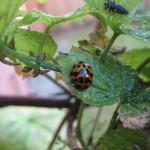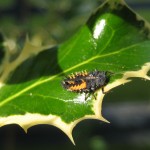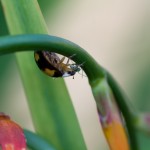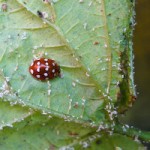A while ago I posted an article about a lack of ladybirds in my garden as well as other insects in general. However, a couple of weeks ago, they arrived en masse (seemingly from nowhere although that was obviously not the case, I just hadn’t noticed them) and settled on the golden hop in the back garden, a traditional haunt of thousands of aphids.
As you may be aware, there has been a lot of press coverage (unusually so for something like a ladybird) of the ‘invasion’ of harlequin ladybirds (Harmonia Axyridis). These ladybirds originate in Asia and have spread (sometimes with our help and knowledge, e.g. they were introduced as pest control agents in some areas) and are thought to have arrived in Britain in 2004. The spread of the harlequin is concerning as it is thought to be a threat to our native species for a number of reasons:
- they have a wider habitat and food range than natives, this includes moth and butterfy eggs and fruit juice
- they disperse over larger areas, rapidly increasing their geographic spread
- when there are fewer aphids about they will eat other ladybird larvae and eggs
- they have a longer breeding season than native ladybirds and so have the potential to increase their numbers more rapidly (they can reproduce after 5 days of adulthood and a single female can lay 1000 eggs)
I spent some time watching the ladybirds wondering if any were harlequins and, if there were, would I recognise them. The answer was yes, and yes. At first glance it can be quite confusing, there are so many different looking ladybirds, not just the traditional two and seven spot ladybirds, there are also black (melanic) forms as well as more yellow and brown ladybirds. However, once you spot a harlequin it is obvious, they are huge in comparison as are the larvae which seem to have more red on them.


If you still feel you need further help there are two fantastic identification charts on the ladybird survey website, one for larvae and one for adults. It is from these that I discovered I had a cream spot ladybird in amongst the two spots.
I was lucky enough to see the ladybirds in all stages of their development. There were larvae of all sizes chasing aphids across the leaves and the top of my wormery. The holly that is next to the golden hop seemed to be a favourite place for pupation and is littered with the cases of what I presume are now adult ladybirds. And, of course there were the myriad of adult ladybirds. I spent quite some time watching a black harlequin (H. axyridis spectabilis) chasing some greenfly along the top of a crocosmia flower stem. Whilst the ladybird wandered along the top and snacked on one of its unfortunate (although I can’t really feel sorry for them) victims its friends escaped along the bottom of the flower!
The ladybirds stayed around for a few days, but then, the rains came, the aphids went (possible eaten) and the ladybirds disappeared as quickly as they had arrived. Since that time I have seen only a couple of two spots in the garden. I did manage to take some photos of the ladybirds, two of which I have included below.

